A Festival to Cherish
by Damodara dasa and Nalini-kantha dasa

Every summer in dozens of cities across the earth, Ratha-yatra—the Festival of the Chariots—blossoms like a multicolored lotus flower. Red, yellow, and green silk canopies tower above the chariots and sway serenely. Their silver decorations glitter in the sunlight. Colossal wooden wheels creak on their axles as singing celebrants haul the ancient vehicles along the parade route, tugging on thick hawsers. By their spirited service they invoke the mercy of Jagannatha, the Lord of the Universe. He is Krishna Himself, the Supreme Personality of Godhead, and He has come along for the ride, sitting on the lead cart in His form as Daru-brahman (God manifested through wood). His big round eyes and blissful smile shower benedictions upon everyone. In the next two chariots sit the Lord’s brother and sister, Balarama and Subhadra. The three vehicles are flower-decked boats rocking on an ocean of friends and devotees, thousands strong, waves of lovers of God singing and dancing. At the parade’s end (a park or a beach) the crowd enjoys a vegetarian feast and entertainment by musicians and dramatists until sunset, and everyone goes home saturated with transcendental peace and joy.
How’ ancient is the Festival of the Chariots? It’s hard to say exactly, but Ratha-yatra is one of the world’s oldest religious festivals. At the 1976 New York Ratha-yatra, His Divine Grace A.C. Bhaktivedanta Swami Prabhupada explained its origins:
“Five thousand years ago Krishna, Balarama, and Subhadra visited Kuruksetra in Their chariot on the occasion of a solar eclipse. One king, Indradyumna, there became very anxious to establish a temple of Krishna, Balarama, and Subhadra. Therefore he got a sculptor to carve the Deities.
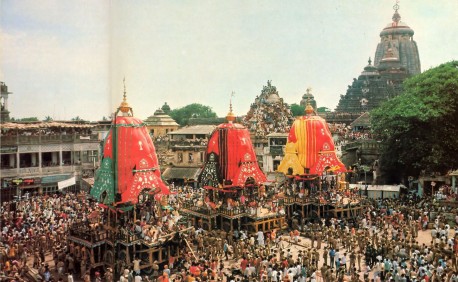

Right: In San Francisco’s Golden Gate Park, eager arms tug hard to help Lord Jagannatha’s six-ton chariot get going.
“But there was a contract between the sculptor and the king that the sculptor would work behind closed doors and the king could not disturb him. When many days had passed the king thought, ‘What is this worker doing?’ So he forcibly opened the door, and he saw that the forms were unfinished. But after that the sculptor would not finish carving the Deities. Therefore the king said, ‘Never mind; I shall worship this unfinished Deity.’

“So you see Jagannatha in this form because King Indradyumna wanted to worship Him in this form. And the king started the temple of Jagannatha in Orissa, at Puri. It is a very old temple—according to modern calculation not less than two thousand years old. The Jagannatha Deity is there. So Krishna and Balarama and Subhadra went to Kuruksetra for the festival, and at Ratha-yatra we also are observing this festival.”
Until very recently, Ratha-yatra was a strictly Indian celebration. It made its way indirectly into Western culture when the British first watched it in Puri and coined the term juggernaut, after the chariots of Jagannatha, to indicate an overwhelming, irresistible force. They felt moved by the immensity of the canopies and wheels, and by the fervor of the devotees’ exultant chanting of the holy names of the Lord. However, the name Jagannatha does not directly mean what juggernaut means. Jagannatha indicates “the Lord of the Universe”—the Lord not just of India and Indians but of the whole universe and all living beings. Therefore, a hundred years ago a devotee of Jagannatha known as Bhaktivinoda Thakura started writing books about Krishna consciousness in English and sending the books to libraries in the West. His son, Bhaktisiddhanta Sarasvati Goswami, carried on the international educational program. The fruition came in 1966, when the Goswami’s most dedicated disciple, His Divine Grace A.C. Bhaktivedanta Swami Prabhupada, founded the International Society for Krishna Consciousness in New York City.
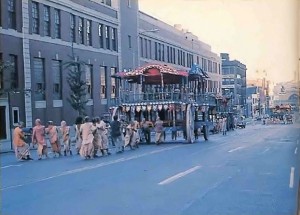
In the summer of 1967, the city of San Francisco saw the Western world’s first Ratha-yatra. Although earlier many other swamis and yogis had journeyed to the West, none of them had brought the purity and devotion of Srila Prabhupada. And none of them had had the vision of Srila Prabhupada: to establish ancient India’s Krishna conscious culture around the world on its own terms—not watered down, but as it is. Thus, Srila Prabhupada introduced Lord Jagannatha as He is, in the original format of the ancient and glorious Festival of the Chariots. Before, no one had dared think it possible, but Srila Prabhupada dared and was triumphant.
Jayananda dasa, one of Srila Prabhupada’s early disciples, took part in every San Francisco Ratha-yatra since the first one back in 1967-and an unusually active part at that. In fact, his expert engineering of the huge chariots used in the San Francisco festivals earned him the nickname “Mr. Ratha-yatra.” For each of the first four Ratha-yatras, Jayananda built the chariots from the ground up. And although in the last few festivals the same vehicles were used each year, still he continued to improve them. To find out the inside story on Ratha-yatra past, present, and future, BACK TO GODHEAD interviewed Jayananda.
Inside Ratha-yatra…With an Old Insider
BTG: Jayananda; how did you first get involved in Krishna consciousness?

Jayananda dasa: I heard Srila Prabhupada speaking in’ San Francisco, and somehow I knew he didn’t want to cheat me. So I just’ wanted to work for him.
BTG: And now for ten years you’ve worked on the Ratha-yatra carts.
Jayananda dasa: Yes.
BTG: What were the first Ratha-yatras like?
Jayananda dasa: The first year, 1967, we just rented a flatbed truck and started out in the Haight-Ashbury district of San Francisco. We decorated the truck with flowers and put the Deities on the back, and the girls passed out fruit. A good crowd walked along with us at the beginning, and when we turned off Haight Street a smaller group of maybe fifty people came with us and we went all the way to the beach.
The second year we made our own cart, with saffron silk canopies, small ones. And we had the parade through Golden Gate Park to the beach. By that time the San Francisco temple had grown a little—we had maybe thirty devotees—and about one hundred people came with us through the park. The chanting was very nice that year.
Then in 1969 we built a much bigger cart, with a tall silk canopy, like the ones they build in Jagannatha Puri in India. But in 1970 we worked for two months straight and built the three big carts, basically the same ones we use now. Also we had all kinds of publicity—TV, billboards, posters. And Srila Prabhupada came to that Ratha-yatra. So a lot of people came, maybe twelve thousand people. It was big—a tremendous success. We had a few mishaps, though. One cart broke down in the middle of the parade. And it was a bitter cold day. But even though it was so cold at the beach, thousands of people stayed there with us and ate a lot of Krishna prasada [spiritual food offered to Krishna]. We brought twenty fifty-gallon barrels of prasada, and they ate it all.

Later that year the auditorium we used at the beach was torn down. So in 1971 we decided to end the parade in the park, at Lindley Meadow. That year, and in 1972 and 1973, the parade was a little smaller than in 1970.
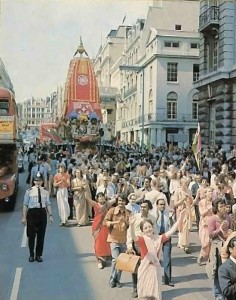
In 1974 Bhakta dasa came to San Francisco to be temple president, and he decided to expand the Ratha-yatra. He spent more money on it than before, and maybe twenty thousand people attended that year. The police remarked that we were the only group that could get such a large gathering together without creating a problem for them. Srila Prabhupada came that year and gave a speech at the Meadow. He was sitting beneath the Jagannatha Deities on Their opulent three-tiered stage. Even without much understanding everyone could appreciate that here was a majestic, awe-inspiring celebration. Another wonderful thing we started that year was the fairground-type booths at the Meadow. You could see the unlimited scope of the Vedic culture. We had a Deity workshop booth, a transcendental art booth, a literature booth, and of course many booths selling food. Now that’s become a regular feature of the festival.
In 1975 I tried out making steel wheels, but the chariots were so heavy they flattened the steel and made the ride very bumpy for the Deities. So now we’re back to the standard wooden wheels.
BTG: What instructions has Srila Prabhupada given you about Ratha-yatra?
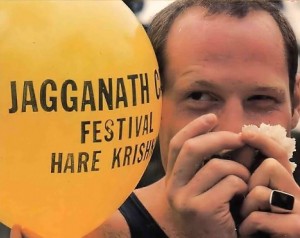
Jayananda dasa: I never got much personal instruction. He just told me to make everything strong. I’m not a real visionary about it—I just built the carts.
BTG: Which Ratha-yatra do you think has been the best so far?
Jayananda dasa: In New York last year-that was the most festive. Not until then had I experienced so many of the transcendental qualities of Ratha-yatra. You know—for a parade there’s nothing like Fifth Avenue; it’s the most important street in the world. And when we went to Washington Square Park to pull the carts home, hours after the parade had finished, thousands of people were still there chanting. They were everywhere. People were coming out of their apartments and coming out of bars shouting “Hare Krishna!” Only in New York could you get such a response.
BTG: Tell us, from your own experience, what the public gets out of Ratha-yatra.

Jayananda dasa: The impact is so powerful that everyone’s affected. In New York there were thousands of people out on the streets, and they were astounded. It’s not that I’m claiming it; the people were interviewed on TV and that’s what they said. Also I remember one man with his girl friend (she didn’t like us at all) who told me some time after the festival that when he saw the carts coming down the street he felt a parade had just come down from heaven, and that he often remembers the carts and the chanting with pleasure. So people are hit by it. It’s so far beyond their usual experience. You can’t measure the impact. All year long they do more or less the same things. Maybe they catch a few parades, like the Thanksgiving Day parade. They stand and watch some big balloons go by. But it’s all the same. Then, when you have a whole troupe of devotees singing and dancing around these lofty, transcendental chariots—then the people are transformed. They used to be mundane creatures, but when they see the Ratha-yatra, they’re angels. It brings out the best in people to see Lord Jagannatha smiling at them. I tell you, at first their faces looked like they hadn’t changed in twenty-five years, and then all of a sudden it was like glass cracking, and you’d see the whole face transformed just by a few moments’ association.
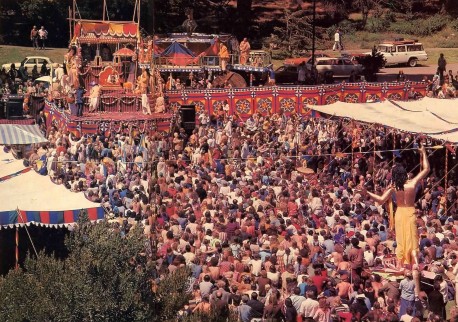
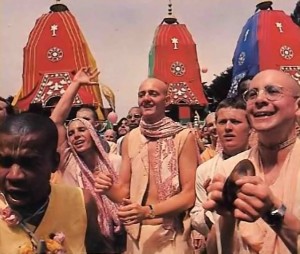
And what to speak of those who take part? Ratha-yatra encourages everybody to take part. “Come on, walk with us, dance, grab a rope and pull.” We don’t say, “Don’t touch.” No—”Join in, have fun.” By our nature we all want to participate. Nobody wants to be a bystander. And those who take part are purified of all their sinful karmic reactions just by chanting Hare Krishna and seeing Lord Jagannatha.
BTG: Are there people who regard it as idol worship?
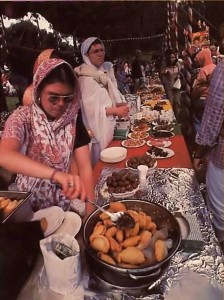
Jayananda dasa: Yes—they may feel that before, but the impact of the festival is so strong that after it they feel otherwise. They see Lord Jagannatha, and they see how merciful He is, and they can feel that it’s not idol worship. And if they read Srila Prabhupada’s books, then they’ll understand logically how Lord Jagannatha is not an idol. Of course, at the festival there are always a few faultfinders. Last year in New York one of them had a bullhorn and was shouting, so one of our men poured water down it and that stopped him.
BTG: What is your understanding of the purpose of Ratha-yatra?
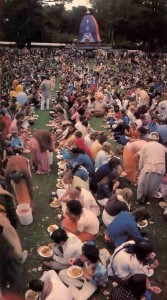 Jayananda dasa: To celebrate the pastimes of Krishna. Krishna’s so kind; He comes to earth and displays so many wonderful pastimes. Ratha-yatra celebrates His going to Kuruksetra with Balarama and Subhadra, and His meeting there with the residents of Vrndavana, where He was born. The expressions of love shared between the Lord and His devotees make that one of the sweetest pastimes. Ratha-yatra offers a chance for so many people to be engaged in Krishna consciousness. People don’t come to our temples much, but millions are out on the streets. Now here’s a chance for them to advance in spiritual life—here comes Lord Jagannatha’s festival! They’re touched—they become part of the transcendental vibration, and they’re purified.
Jayananda dasa: To celebrate the pastimes of Krishna. Krishna’s so kind; He comes to earth and displays so many wonderful pastimes. Ratha-yatra celebrates His going to Kuruksetra with Balarama and Subhadra, and His meeting there with the residents of Vrndavana, where He was born. The expressions of love shared between the Lord and His devotees make that one of the sweetest pastimes. Ratha-yatra offers a chance for so many people to be engaged in Krishna consciousness. People don’t come to our temples much, but millions are out on the streets. Now here’s a chance for them to advance in spiritual life—here comes Lord Jagannatha’s festival! They’re touched—they become part of the transcendental vibration, and they’re purified.
Also, for the devotees it’s very beneficial—maybe more for me; Ratha-yatra is the service that’s given me so many of my realizations, the flowering of whatever Krishna consciousness I have. It’s not a long-term occupation. It happens all at once, like a big explosion, in the summer. It brings together so many devotees all working together under the spiritual master with one plan. And all the transcendental paraphernalia is there-the Deities, the prasada, the chanting, the booths, the theater—it’s such a surcharged atmosphere. You never forget it. For a devotee to be able to participate in Ratha-yatra is very good for his Krishna consciousness. When you have these festivals, it gives you a big, powerful event to look forward to, and to work towards. It helps your devotion.
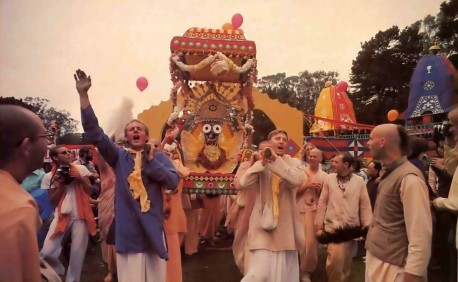
BTG: How about the future growth of Ratha-yatra?
Jayananda dasa: One thing that’s important is that all the temples should celebrate this wonderful festival. But it isn’t practical for each center to construct three carts. So now in Los Angeles we’re putting together a traveling party that can go from city to city, with displays and carts that you can assemble and take apart. Then the great expense will be eliminated. Also, we’ll have year-round Ratha-yatras—the South in the winter, the North in the summer. It can be expanded so people will be hearing about Ratha-yatra all year round-and that will be the perfection of their lives!
BTG: It sounds wonderful. Thank you very much, Jayananda.
Jayananda dasa: Thank you. Hare Krishna.

Leave a Reply